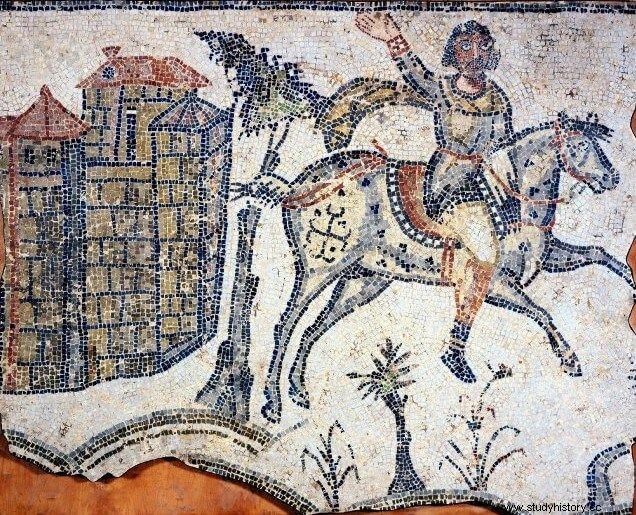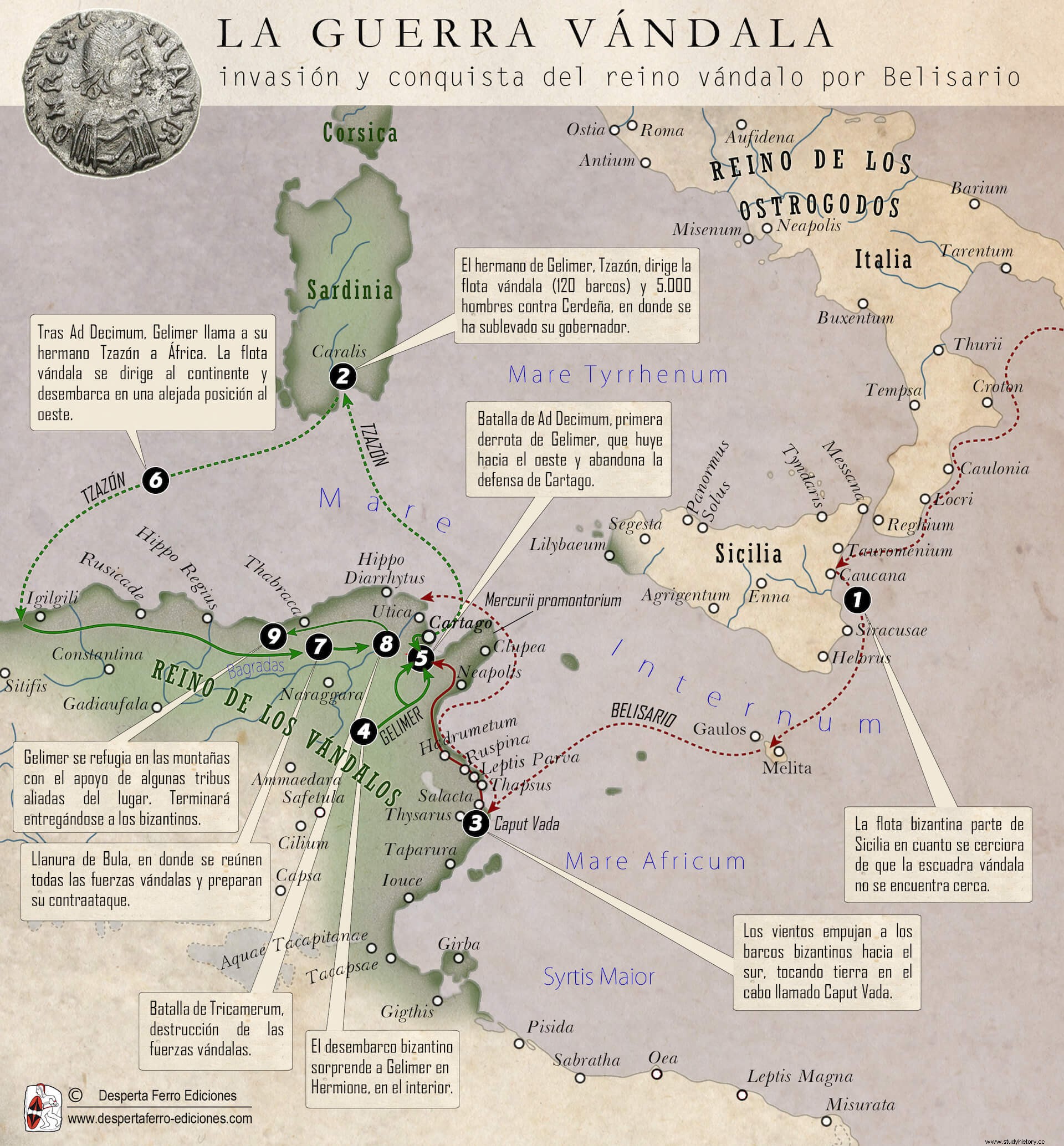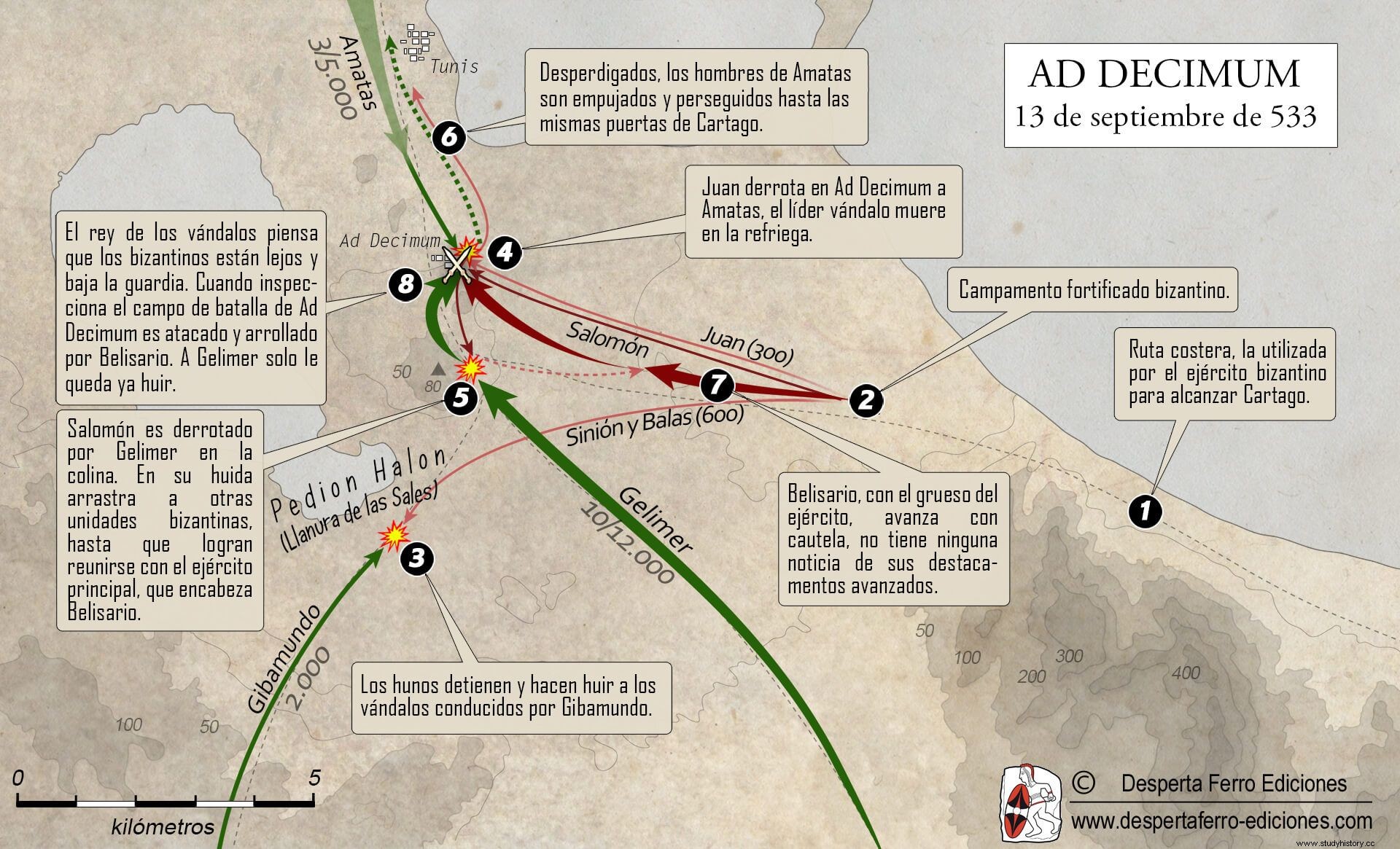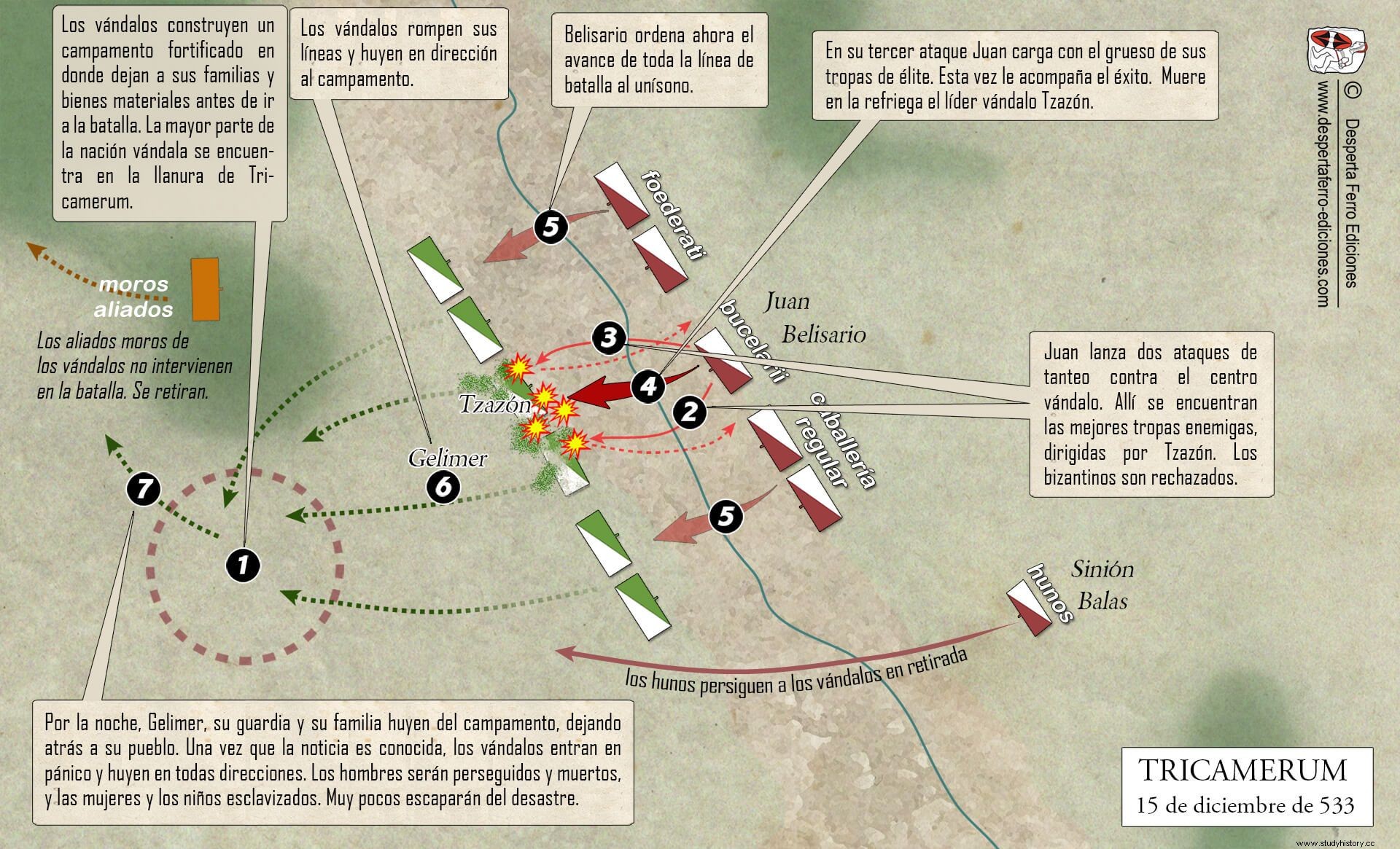
After a long journey across the Mediterranean, in fall 533, Welisario he landed in Sicily, where he learned that, far from expecting an attack, Gelimer, king of the Vandals, was in the south of the country, in the city of Hermione, four days' march from the coast. He also learned that Gelimer had sent 5,000 soldiers and 120 ships under the command of his brother Tzazón to suppress the revolt in Sardinia by a certain Godas. Buoyed by the news that he could safely land in Africa, Belisarius ordered his troops to re-embark and weighed anchor.
The Byzantine Army docked off the North African coast, near the city of Leptis Magna , about three months after his departure from Constantinople. Although many scholars accept the low figure given by Procopius, a closer reading reveals that Belisarius commanded a considerable force. His army consisted of 10,000 infantry and 5,000 cavalry, as many regulars as foederati . It also included 400 Heruli commanded by Faras and 600 Huns commanded by Sinión and Balas. Accompanying Belisarius was his personal guard ( bucellarii andcomitatus ), although we are not given the figure for it. To transport this army, there were 500 ships, manned by 30,000 sailors under the command of Calónimo de Alejandría, and 92 vessels of war (dromones ) manned by 2,000 men who were expected to land and fight if necessary. This was the army with which Justinian hoped to conquer Vandal Africa.
After the landing, Belisarius began the advance towards Carthage. For the march he placed 300 bucellarii in front led by John the Armenian, his optio , with instructions to scout the road and report any enemy activity. They should stay at least 20 stades (3.6 km) ahead of the main body of the army. The 600 Huns under Sinion and Balas were to similarly garrison the left flank, also remaining at least 20 stades away. of the main column. Belisarius moved to the rear with the rest of his bucellarii and comitatus , in case there was an attack from Gelimer from behind, while the rest of the army marched in the center of the formation. The fleet was ordered to keep up with the troops as they moved along the coast road and no protection was provided on the right flank as it faced the sea and was therefore protected by the ships.
When Gelimer When he heard that Belisarius had landed, he reacted quickly. He ordered his brother Ammatas, who had remained in Carthage, to gather troops to stop the Byzantines at the Ad Decimum pass, where the road cut through a series of steep hills. For his part, he gathered the troops from the south and set out to meet his brother.
Marching at a speed of 80 stades (14.4 km) to the day, the Byzantine army advanced towards Carthage, occupying the towns of Leptis and Hadrumetum in its advance. They finally reached Grase, 350 stades away (63 km) from Carthage, and where the Vandal king had a palace. Belisarius was aware that the Vandals would be close, but his strength and position were unknown to him. And while the army was preparing to camp at Grase, a detachment of the Byzantine rearguard clashed with some of Gelimer's forward troops. After a brief skirmish both sides retreated to their camps, but Belisarius already knew that there were at least a few Vandals in the vicinity, following close behind.

Leaving Grase, Belisarius had to follow the route that he was moving away from the coast, so his ships could no longer directly support the army. He ordered the fleet to round Cape Bon but keep to 200 stades (36 km) from Carthage, while his army, on the fourth day from their landing, advanced towards Ad Decimum. At most his strength would amount to 18,000 men.
Decimum, where the path passed through a “narrow passage”, was 70 stades (12.6 km) from Carthage and that is where Gelimer planned to ambush the Byzantines. His plan was simple:Ammatus was to break out of Carthage and block the northern exit of the valley, a position from which he could attack the vanguard of the Byzantine column as it tried to break out. He expected this to cause confusion and disorder, with the Byzantines confined to a narrow space, while he advanced from the south to attack his rear. Disorganized and attacked from two directions, Belisarius's army would be destroyed. Gelimer's plan was simple and elegant, but it had a drawback:it depended on the two attacks coinciding in time, and it would not be easy to coordinate them.
We do not have a figure for the Gelimer and Ammatus troops . The total of the Vandal army must have been only around 15,000 men, due to the losses of previous wars and the fact that 5,000 of his best men were with Tzazón in Sardinia. But it is unlikely that Gelimer could muster it all, due to the urgency of the situation and the time it took him to complete the recruit, so he must have had 10,000-12,000 men, with 3,000-5,000 men with Ammatus. /p>
According to Procopius, there were three roads in the vicinity that led to Carthage , neither visible from the other due to the hills between which they ran. The first route was the coastal route that the Byzantines were following, passing through Ad Decimum before heading towards Carthage. The central path came from the south, and it was the one that Gelimer was using in advancing him from Hermione. This route intersected the coastal one a little before the Decimum pass. And the third path, which seems to have bothered Gelimer, was further inland and circled the valley, following a different route to Carthage. If Ammatus followed his king's instructions, the city would be left defenseless:even a small Byzantine force could advance unopposed to Carthage along this route, and the citizens, Orthodox Christians - the Vandals were Arians - might open the gates to their enemies. coreligionists. Gelimer changed his plans and sent his nephew Gibamundo with 2000 men to secure the third route and Carthage.
In contrast, Warbringer did not want a battle and he had no plans to fight her. He still had no clear idea of the potential of the Vandal army or its composition. What he needed was information that he could use to plan a battle that, at the earliest, he would give the next day.
The Battle of Ad Decimum
Per Gelimer's instructions, on the morning of the fourth day since the invasion, Ammatus ordered his men to follow him into the pass, leading the way himself to scout the area. and decide the deployment.
As the Vandals headed towards Decimum, Warbringer was also approaching the valley. About 6 km from Decimum the Byzantines reached a suitable position to camp and Belisarius put the infantry to fortify it. With the baggage in relative safety, he set out with the cavalry at his disposal in search of the Vandals, with Uliaris, commander of his guard, leading 800 men. John the Armenian and his 300 cavalry were well ahead of the main force and, at a similar distance, the Huns on the left flank. Unsure of the enemy's position, Belisarius sent the rest of the foederati with Salomón to contact Juan and try to locate the vandals. The Byzantine general did not yet know that both John in the vanguard of him and the Huns of Sinnion and Balas to the left of him had already clashed with the enemy:the battle of Ad Decimum had begun.
Ad Decimum phase 1:Gibamundo's defeat
The two crashes took place almost at the same time. Around noon, Gelimer's nephew Gibamundus and his 2,000 men encountered the 600 Huns as they marched down the third road, near Pedion Halon, 40 stades away (7.2km) from Decimum. Although they outnumbered the Huns, the Vandals were halted when a single Hun, riding ahead of the rest, engaged them:Procopius argues that they feared their reputation as fierce warriors. His inaction spurred the Huns, who immediately attacked. Without even attempting to resist, Gibamundo was killed and his man defeated and destroyed.

Ad Decimum phase 2:defeat by Ammatus
At the same time, Ammatus had advanced towards Decimum with a handful of troops to survey the possible battlefield, while the rest of his troops followed in small groups of no more than 30 men, scattered in a long column. When around noon he reached Decimum, Ammatus unexpectedly met John the Armenian and his 300 bucellarii , who advanced prominent from the Byzantine bulk. Despite finishing with 12 bucellarii Ammatus fell in battle and the rest of his small force fled in the direction of Carthage, with John and his men hot on their heels. Unable to concentrate their forces and organize a defense, the small groups of Vandals marching down the road towards Decimum turned and fled, in a kind of domino effect. The trickle turned into a flood, with all of Ammatus's troops fleeing as far as Carthage. Juan arrived at the very gates of the city, to then slowly go back the way they had come while they were stripping the vandal corpses.
Ad Decimum phase 3:Gelimer's arrival
Meanwhile, the foederati The Byzantines commanded by Solomon - whom Belisarius had detached to contact John - reached the point where he had begun the fight with Ammatus. After questioning some of the townspeople, Solomon was unsure what to do, so he climbed a nearby hill to get some perspective. From there he saw a cloud of dust approaching from the south:it was Gelimer and the bulk of the Vandal forces. He immediately sent messengers to Belisarius, urging him to come to his aid as soon as possible.
Unfortunately, Solomon and his officers argued over whether or not to attack the Vandals, a debate that would only be academic:between the armies there was a hill, the highest of area. Individuals from both armies realized its tactical importance and took up the fight for it. After a tough fight the Vandals were the first to reach the top and from there, taking advantage of attacking downhill and their numerical superiority, they defeated the foederati . They fled in a panic, trying to catch up with Belisarius and his reinforcements, and fell back to a position held by Uliaris's 800 men who, as we have said, advanced ahead of the bulk of the Byzantine troops. The foederati They expected the bodyguards to join him in meeting the attack, but they were in for a surprise:learning of defeat, the Guard disbanded and fled towards Warbringer.
The fleeing troops reached his position, and his immediate reaction was to reform his lines before berating them for fleeing. He then listened to the reports from him, from which he quickly surmised that Gelimer had stopped and that a large number of Vandals had already been defeated. He also suspected that his troops were numerically superior to the enemy. He had a chance to deal a decisive blow to the Vandals, so he ordered his troops to march at full speed towards Decimum.
There Gelimer also had to make a decision:he could go after the foederati or march to Carthage. Instead, he came down from the hills at a pass and found the corpse of his brother Ammatus. Instead of acting, Gelimer began to mourn and prepare for the funeral, and the Vandal troops were allowed to break formation and scatter across the pass. Although, following Procopius, there is the traditional version, it should be noted that Gelimer had to face another problem:he did not know that his brother had been defeated by only 300 men, and would have assumed that the Byzantines had advanced more quickly than expected, falling on Ammatus en masse. He probably believed that the Byzantine bulk was approaching Carthage, and he had to make a decision about it. As he pondered, disaster struck.
Ad Decimum phase 4:Warbringer's arrival and Gelimer's defeat
Belisarius arrived with his troops in order and hastily attacked the disorganized Vandals who, surprised, fled, although not in the direction of Carthage:they believed that a Roman army had already advanced in that direction and did not want to be caught between two forces. They fled across the fields to the relative safety of the Bulla plain and the road that led to Numidia.
The battle of Ad Decimum was over and Carthage was at the mercy of the victor. With Gelimer and the main Vandal force moving away from the city, there were not enough troops in the city either to withstand a Byzantine assault or to prevent the population from opening the gates. Belisarius entered Carthage in triumph. He had won the first round.
The Battle of Tricamerum
About three months after his landing in Africa, after spending time in Carthage repairing the defenses and reorganizing his men, Belisarius left the city for the decisive battle. He sent all his cavalry and his bucellarii , except 500 men, under the command of Juan de Armenia against the Vandal camp at Tricamerum. Juan had orders to skirmish with the enemy if the opportunity arose, but not to accept a full-fledged battle. The next morning Belisarius followed with the remaining cavalry and infantry. Meanwhile, the Byzantine cavalry had broken up their camp, leaving a wide distance from the enemy.
After the battle of Ad Decimum, Gelimer's brother, Tzazón, had returned from Sardinia with 5,000 men from him, and the Vandal monarch was willing to risk a pitched battle. Just before noon the day after the Byzantine army arrived, Gelimer led his troops out of camp and formed up behind a small stream. In the center Tzazon was deployed at the head of his veterans of the Sardinian campaign and on the flanks the Vandal chiliarchs with the rest of the army. They hoped that during the battle the Byzantines would concentrate against the center and not on the wings, which were weaker, and that they would probably have a similar size. Behind the Vandal center was a force of Moorish allies, the size of which we do not know. They had joined Gelimer for battle, but decided to wait until the outcome of the battle was clear before going into action, so they spread out at a distance from which they could observe events without being forced to fight.
The Vandal deployment caught the Byzantines off guard, and John the Armenian gave orders to form up on the opposite bank of the stream. On the left flank was a part of the mounted archers, reinforced by the foederati , armed only for melee; probably 3,500-4,000. The rest of the cavalry was arranged on the right, at most about 4000 horsemen, and in the center the bucellarii and the army banner. In the previous months Gelimer had sent messengers to Belisarius's Huns asking them to come over to him, so like the Moors they deployed separately from the Byzantine army, allowing them to choose sides when they saw who was on the side of the fight. /P> 
Belisiaro arrived on the battlefield a little later :Leaving the infantry behind, he sped off like the rest of the bucellarii and he showed up shortly before the fight broke out.
The fight began when the Byzantines sent a few troops to harass the Vandal center, either to disorganize it or to provoke a counterattack that lost steam and cohesion crossing the stream. Tzazon apparently saw through the ruse and ordered a limited charge that forced the Byzantine skirmishers to retreat, but did not cross the river.
John or Belisarius reached an important conclusion:although the Vandals were not going to take the bait, their center was weakening under the action of the Byzantine archers. Also, his two wings had not moved to support Tzazon. In a decisive move, Juan led almost the entire comitatus in a direct attack against the vandal center; a fierce hand-to-hand combat ensued in the course of which the Vandal leader fell dead.
As the Vandal center gave way, the flanks could not come to their aid, fixed in position by the Byzantine line. It was then that Belisario ordered an all-out attack , at the crucial moment. The Vandal center collapsed, and in the flight he spread his panic to the wings:in moments the Vandal army was disbanded in terror. The Huns joined the pursuit, declaring their allegiance to Belisarius.
The pursuit was brief:the Vandals returned to their camp, and as the Byzantine infantry had not yet arrived, Belisarius did not have the troops to assault him. Instead the Byzantines set about stripping enemy corpses. Procopius states that the Byzantine losses were 50 dead, for 800 Vandals. The Battle of Tricamerum was over.
After the combat Gelimer escaped from the camp before being killed or handed over to the Byzantines and took refuge in the mountains. Shortly thereafter, having been assured of his safety, he surrendered, and the Vandal resistance collapsed. In just three months Belisarius had defeated the Vandals, winning the ancient province of Africa for Justinian and undying fame for himself.
Fonts
- Procopius:History of wars. Vandal War , books III-IV, trans. Flores Rubio, J. A., Gredos (2000).
Bibliography
- Greatrex, G. (1998):Rome and Persia at War, 502-532 , Francis Cairns.
- Hughes, I. (2009):Belisarius:The Last Rom an General , Barnsley.
- Lillington-Martin, C. (2007):“Archaeological and Ancient Literary Evidence for a Battle near Dara Gap, Turkey, AD 530:Topography, Texts &Trenches”, BAR –S1717, pp 299-311.
- Treadgold, W. (1995):Byzantium and Its Army, 284-1081 , Stanford.
